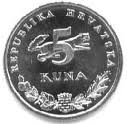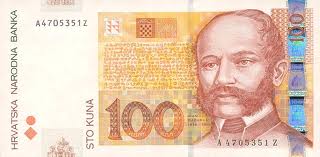|


The kuna is the currency of Croatia (ISO 4217 code: HRK). It is subdivided into 100 lipa. The kuna is issued by the Croatian National Bank and the coins are minted by the Croatian Monetary Institute.
The word "kuna" means "marten" in Croatian since it is based on the use of marten pelts as units of value in medieval trading. It has no relation to the various currencies named "koruna" (translated as kruna in Croatian). The word lipa means "linden (lime) tree".
Earlier usage
During Roman times, in the provinces of upper and lower Pannonia (today Hungary and Slavonia), taxes were collected in the then highly valued marten skins. Hence, the Croatian word "marturina" or tax, derived from the Latin word "martus" (Croatian: "kuna"). The kuna was a currency unit in several Slavic states, most notably Kievan Rus and its successors until the early 15th century. It was equal to 1⁄25 (later 1⁄50) gryvna of silver.
In the Middle Ages, many foreign monies were used in Croatia, but since at least 1018 a local currency was in use. Between 1260 and 1380, the Croatian Viceroys were making a marten-adorned silver coin called the banovac. However, the diminishing autonomy of Croatia within the Croatia-Hungarian Kingdom led to the gradual disappearance of that currency.
The idea of a kuna currency reappeared in 1939 when the Banovina of Croatia, established within the Yugoslav Monarchy, planned to issue its own money.
In 1941, when the Ustaše formed the Independent State of Croatia, they introduced the Independent State of Croatia kuna. This currency remained in circulation until 1945, when it along with competing issues by the socialist Partisans disappeared with the establishment of a socialist state.
Kuna since 1994
The modern kuna was introduced on May 30, 1994, starting a transitional period from Croatian dinar, ending on December 31, 1994. The exchange rate between dinar and kuna was 1 kuna = 1000 dinars.
An alternative proposition for the name of the new currency was kruna (crown) after the Austro-Hungarian krone. However, this proposition was challenged on the same basis as the previous, since the kruna was proposed to be divided in 100 banica. Additionally, terms like kruna (crown) and banica (viceroy's wife) were found inappropriate for the country which is a republic.
The transition to the new currency went smoothly and the controversy quickly blew over.
The self-proclaimed Serbian entity Republic of Serbian Krajina did not use the kuna or the Croatian dinar. Instead, they issued their own Krajina dinar until the region was integrated back into Croatia in 1995.
The main reference currency for kuna was the German Mark, and later the Euro. A long-time policy of the Croatian National Bank has been to keep the fluctuations of the kuna exchange rate with the euro in a relatively stable range. The country has been on the path of accession to the European Union and it plans to join the European Monetary System.
Coins
In 1994, coins were introduced in denominations of 1, 2, 5, 10, 20 and 50 lipa (Croatian word for linden or tilia tree), 1, 2 and 5 kuna. The coins are issued in two versions: one with the name of the plant or animal in Croatian (issued in odd years), the other with the name in Latin (issued in even years).
The text on this page has been made available under the Creative Commons Attribution-ShareAlike License and Creative Commons Licenses
| 